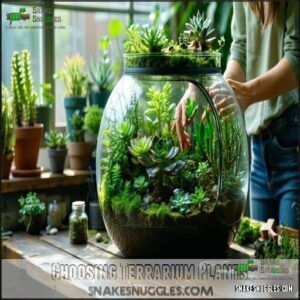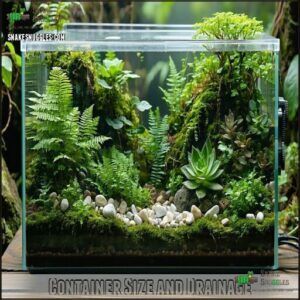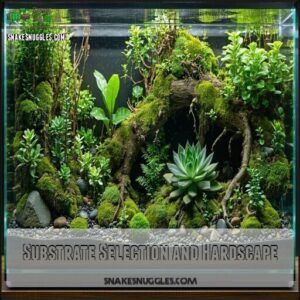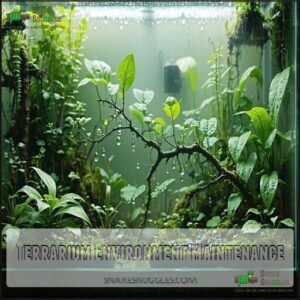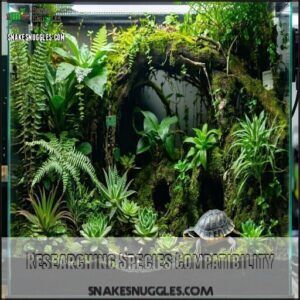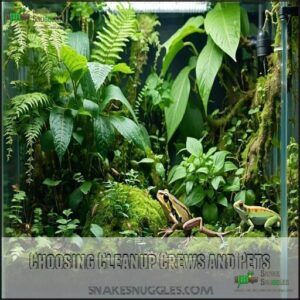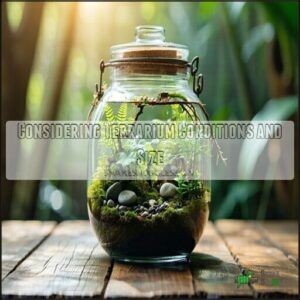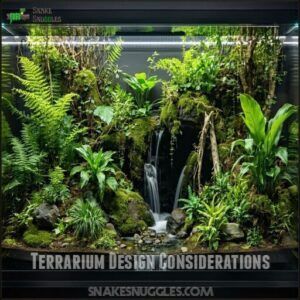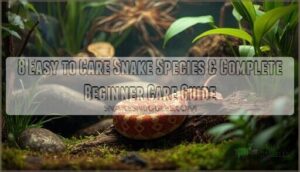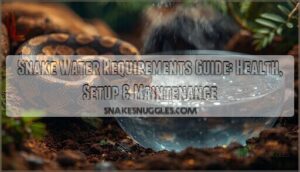This site is supported by our readers. We may earn a commission, at no cost to you, if you purchase through links.
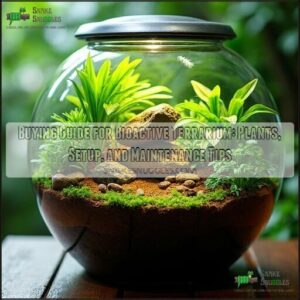 A bioactive terrarium mimics a natural ecosystem, so start with proper planning.
A bioactive terrarium mimics a natural ecosystem, so start with proper planning.
Pick sturdy live plants that thrive in your pet’s environment—like pothos or ferns—and verify they match its size and humidity needs. Choose a container with good drainage, layer substrates like soil and leaf litter, and add hardscape features like rocks or wood.
Don’t forget the “cleanup crew”—isopods and springtails keep things tidy by breaking down waste. Keep the lights, temperature, and humidity balanced, and your microfauna (and pets) happy.
It’s like crafting a tiny jungle—challenging but rewarding! Curious about design hacks or specific species? Keep reading to explore more about bioactive terrarium and microfauna.
Table Of Contents
- Key Takeaways
- Choosing Terrarium Plants
- Bioactive Terrarium Setup
- Terrarium Environment Maintenance
- Selecting Bioactive Species
- Terrarium Design Considerations
- Frequently Asked Questions (FAQs)
- How do I choose a bioactive terrarium?
- How to maintain a bioactive terrarium?
- What is a bioactive terrarium?
- How do I choose a terrarium?
- What is the substrate in a bioactive terrarium?
- Are bioactive terrariums good for pets?
- What all do I need for a bioactive terrarium?
- Are bioactive enclosures worth it?
- How many isopods do I need for a bioactive terrarium?
- Are bioactive terrariums hard to maintain?
- Conclusion
Key Takeaways
- Pick the right plants, microfauna, and substrate layers to balance humidity, lighting, and airflow in your terrarium.
- Add a cleanup crew like isopods and springtails to manage waste and keep your ecosystem self-sustaining.
- Choose a spacious container with proper drainage and ventilation for healthy plant and pet growth.
- Maintain your terrarium by monitoring moisture, trimming plants, and feeding the microfauna occasionally.
Choosing Terrarium Plants
When choosing terrarium plants, it’s important to evaluate their light, soil, and humidity needs to guarantee they thrive.
Pick species that won’t outgrow your space or compete with others, and remember, healthy plants mean a healthy ecosystem.
Recommended Live Terrarium Plants
Choosing the right live terrarium plants makes your bioactive setup vibrant and healthy.
Stick to species that thrive in humid environments for easy maintenance.
- Moss Types: Sheet moss or pillow moss create a lush carpet.
- Fern Species: Try maidenhair or button ferns for elegance.
- Air Plants: Low-maintenance, great for vertical interest.
- Leaf Selection: Dense foliage like pothos works wonders.
- Plant Choices: Fit lighting and humidity needs.
Plant Size and Growth Habits
When choosing terrarium plants, think about their height, growth rates, and leaf spread.
Some plants grow quickly and might outpace others, while compact ones keep things balanced.
Check stem thickness and root depth since overgrowth can crowd your setup.
Live terrarium plants with manageable growth make care easier, keeping your bioactive terrarium vibrant without overstuffing its space.
Lighting and Soil Considerations
Good terrarium lighting isn’t just for looks—plants need proper lighting cycles to thrive. LED lighting or grow lights mimic natural sunlight, fueling photosynthesis.
Pair this with bioactive substrates that balance soil pH and retain soil moisture. Terrarium soil should support roots without waterlogging.
Remember, vivarium lighting affects plant health, so adjust accordingly for healthy, vibrant growth.
Bioactive Terrarium Setup
Setting up a bioactive terrarium means creating a mini-ecosystem with proper layers like drainage, substrate, and hardscape.
You’ll also introduce bugs and microbes to recycle waste and keep everything healthy, which is a complete concept in itself but related to the initial setup.
Container Size and Drainage
Terrarium containers need proper drainage layers for water management.
Glass containers work best—choose one large enough for healthy substrate depth and growth.
Prevent leaks with sturdy materials and make certain the drainage layer keeps waterlogging away.
Here’s how:
- Use LECA or gravel for drainage.
- Add a mesh barrier.
- Check for leaks.
- Avoid narrow tops.
- Keep substrate above water reserves.
When setting up a bioactive terrarium, selecting the right terrarium containers is vital for maintaining a balanced ecosystem.
Proper water management and choosing the right materials are key to a successful terrarium, ensuring the drainage layer functions correctly.
Substrate Selection and Hardscape
When building your bioactive terrarium, begin with sturdy drainage layers like LECA or gravel to prevent waterlogging.
Create a rich substrate mix—blend coir, soil, and bark for balanced soil composition.
Add hardscape materials like rocks or driftwood for structure and style. Rock selection matters; go for natural textures.
With thoughtful substrate selection and hardscaping, you’ll craft a beautiful, thriving ecosystem. Understanding the right Terrarium Substrate components is essential for a healthy environment.
Introducing Bioactive Bugs and Microflora
Once your substrate and hardscape are set, it’s time to introduce life into your bioactive ecosystem.
Bioactive bugs like springtails and isopods, paired with beneficial microorganisms, maintain microbe balance by breaking down organic material.
Springtails and isopods work tirelessly to recycle waste, balance microbes, and keep your terrarium’s ecosystem thriving naturally.
These detritivores control fungal growth and recycle nutrients.
Care for them by ensuring proper humidity, supplemental food, and room for thriving bug colonies. Balance equals survival!
To achieve a thriving bioactive environment, understanding bioactive substrate selection is essential for the health of your ecosystem.
Terrarium Environment Maintenance
Keeping your terrarium’s environment stable is essential for a healthy ecosystem.
You’ll need to watch humidity, airflow, and provide a little extra food for your microfauna when nature needs a hand.
Monitoring Temperature and Humidity
Keep your terrarium’s climate cozy with precise temperature control and humidity levels.
Use a digital thermometer and hygrometer for accurate climate monitoring. Place sensors near the substrate for better thermal regulation.
Daily checks prevent surprises—too dry, and your microfauna sulks; too wet, and mold takes over. Think of it as giving your terrarium its perfect spa day!
Maintaining the right temperature gradients is essential for a healthy environment with proper temperature control and humidity levels.
Ventilation and Air Exchange
Good airflow isn’t just a luxury—it’s the spine of a happy terrarium.
Ventilation systems maintain healthy oxygen levels and prevent carbon dioxide buildup. Effective air circulation keeps humidity control in check while helping plants and critters thrive.
- Use mesh lids or vents for consistent air exchange.
- Avoid sealing the terrarium completely.
- Position ventilation systems to balance air and humidity, ensuring a healthy environment for happy terrarium.
Supplementing Food for Microfauna
Feeding your microfauna isn’t complicated but helps nutrient cycling thrive.
Offer supplement types like crushed fish food, vegetable scraps, or specialty pellets.
A balanced microfauna diet supports beneficial microorganisms in your bioactive terrarium.
Stick to light, regular feeding schedules, similar to sprinkling breadcrumbs, and watch live terrarium plants flourish as these tiny workers recycle waste into nutrients for the ecosystem.
Selecting Bioactive Species
Selecting the right bioactive species for your terrarium is all about balance and matching conditions.
You’ll want to make certain your plants, bugs, and pets thrive in the same temperature, humidity, and space without competing for resources.
Researching Species Compatibility
When setting up a bioactive terrarium, species selection matters.
Think harmony—plants, cleanup crews, and terrarium animals should coexist beautifully.
Research pet compatibility and microfauna balance to avoid clashes.
For reptiles or amphibians, consider their habits and environment.
Bug selection depends on waste needs, but they’re not picky roommates.
Balance is everything; mismatched species disrupt rather than enhance your ecosystem.
Choosing Cleanup Crews and Pets
When choosing cleanup crews and pets, think of balance.
Your bioactive terrarium thrives with these helpers:
- Isopods: Great for breaking down leaves and waste.
- Springtails: Mold-busters that love moisture.
- Dwarf white isopods: Perfect for reptile care setups.
- Earthworms: Natural composters.
- Tiny frogs or geckos: Add life while complementing the bioactive ecosystem.
Understanding the importance of a bioactive ecosystem is essential for maintaining a healthy environment.
Keep your microfauna management steady!
Considering Terrarium Conditions and Size
Your bioactive terrarium’s success depends on understanding terrarium size and conditions.
Make sure the container size suits your species’ space requirements while allowing proper air exchange and moisture levels.
Depth matters too—plants and cleanup crews thrive in a mini ecosystem with stable terrarium conditions.
A well-thought-out balance simplifies terrarium maintenance, keeps everyone happy, and prevents overcrowding or imbalance, ensuring a bioactive terrarium with proper air exchange.
Terrarium Design Considerations
When designing a bioactive terrarium, you’ll want to think about creating a space that balances function and beauty.
From glass enclosures to hardscape materials, every detail plays a role in supporting your ecosystem while looking great.
Glass Terrariums and Ventilation Designs
A solid glass terrarium guarantees clarity and durability while managing temperature.
Ventilation design is key for air exchange and humidity control. Look for mesh-covered openings and snug lids to prevent moisture buildup while keeping airflow steady.
Consider these factors:
- Front-opening vs. closed terrariums.
- Mesh placement for air exchange.
- Terrarium lids for humidity control.
- Ventilation enhancing plant health.
Proper glass terrarium ventilation is vital for maintaining a healthy environment with proper airflow.
Aesthetics and Hardscaping Elements
Rock decor, wood accents, and bark features can transform your terrarium into a natural masterpiece.
Driftwood designs and moss landscaping add depth and texture, creating a thriving environment that’s visually stunning.
Driftwood and moss transform terrariums into vibrant, miniature jungles, blending beauty and balance for a thriving ecosystem.
With a thoughtful terrarium design, every element of hardscaping enhances aesthetic appeal while supporting plant and pet needs.
Think of terrarium decoration as crafting a miniature jungle—functional and beautiful.
Materials and Substrate Selection
To keep your bioactive terrarium thriving, start with a solid drainage layer like LECA or gravel.
It prevents waterlogging and keeps roots happy. Next, a bioactive substrate mix combining coconut coir, organic matter, and bark supports plants and bugs.
Creating a naturalistic terrarium setup involves careful planning and execution.
Go for terrarium supplies like charcoal and moss for aeration. Pick terrarium substrate carefully—your plants and cleanup crews will thank you!
Frequently Asked Questions (FAQs)
How do I choose a bioactive terrarium?
Pick a spacious terrarium with good ventilation and drainage.
Consider your pets’ size, humidity needs, and lighting. Add layered substrates, microfauna, and plants to mimic nature.
It’s like building a mini rainforest—fun and rewarding!
How to maintain a bioactive terrarium?
Check moisture levels regularly, trim overgrown plants, and remove dead leaves to keep things tidy.
Feed cleanup crews occasionally, guarantee proper humidity, and spot-check for pests.
Think of it as gardening with a built-in cleanup team!
What is a bioactive terrarium?
A bioactive terrarium is a self-sustaining ecosystem where plants, microfauna, and cleanup crews like isopods and springtails work together.
It mimics nature, recycling organic waste into nutrients while maintaining balance for thriving inhabitants, creating a bioactive environment.
How do I choose a terrarium?
Over 90% of terrarium success depends on the right size and material.
Choose glass for clarity and durability, ensuring it suits your species’ space and humidity needs.
Larger ones support biodiversity and vibrant ecosystems.
What is the substrate in a bioactive terrarium?
The substrate acts like the terrarium’s foundation, blending soil, moss, charcoal, and bark.
It retains moisture, supports plants, and houses cleanup crews (like isopods).
Think of it as the heartbeat of your bioactive ecosystem!
Are bioactive terrariums good for pets?
They’re fantastic for pets needing natural habitats!
Cleanup crews manage waste, plants improve air, and the ecosystem feels homey.
Just match the terrarium to your pet’s humidity, space, and diet preferences for a happy companion.
What all do I need for a bioactive terrarium?
Building a bioactive terrarium takes a recipe for life: you’ll need a suitable container, drainage layer, substrate, live plants, microfauna (like isopods and springtails), lighting, and consistent humidity and temperature control.
To maintain balance in your terrarium, it’s essential to have consistent humidity and temperature control, as this will help create a stable environment for your plants and microfauna to thrive.
Are bioactive enclosures worth it?
Bioactive enclosures create self-sustaining ecosystems, cutting your cleaning time while keeping pets healthier and happier.
They mimic nature, recycle waste, and look amazing.
If you enjoy low-maintenance, thriving setups, they’re definitely worth it.
How many isopods do I need for a bioactive terrarium?
Think of isopods as the janitors of your terrarium. For a small setup (10 gallons), start with 10-20 isopods. Larger terrariums need more—1-2 isopods per gallon guarantees effective waste management.
Are bioactive terrariums hard to maintain?
Bioactive terrariums aren’t hard to maintain if you set them up right.
Cleanup crews like isopods and springtails handle waste, plants recycle nutrients.
You’ll just monitor humidity, trim plants, and occasionally top off food.
Conclusion
Crafting a bioactive terrarium blends creativity with science, making it both fun and practical.
By choosing the right plants, setting up layers properly, and balancing humidity and lighting, you create a thriving mini-ecosystem.
Don’t skip the cleanup crew—they’re the unsung heroes keeping everything in check.
Whether you’re housing reptiles or just exploring microfauna, this buying guide for bioactive terrarium guarantees every step is clear.
Commit to regular maintenance, and your tiny jungle will reward you with beauty and balance.

